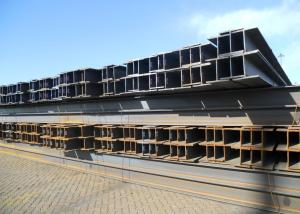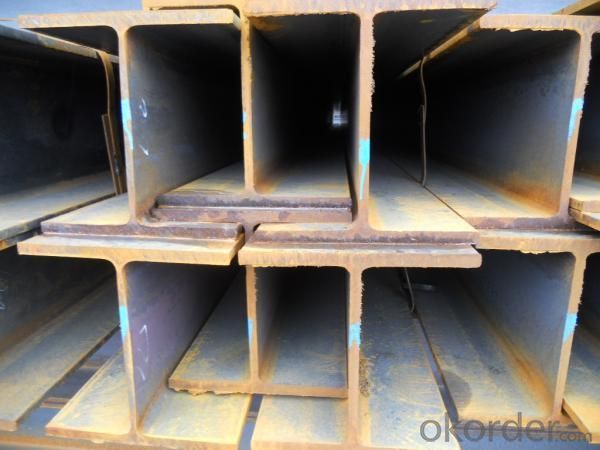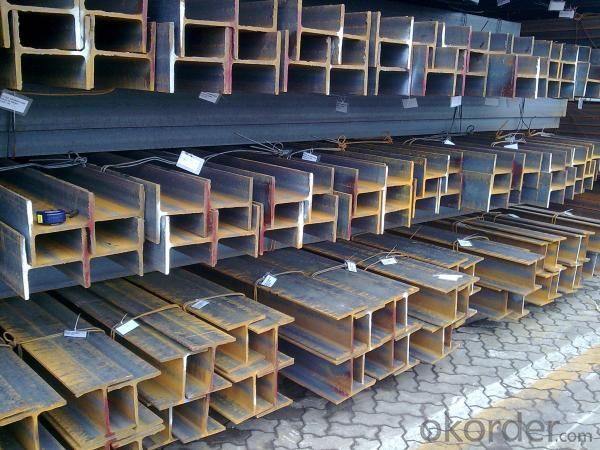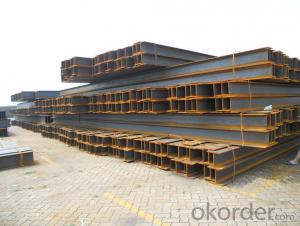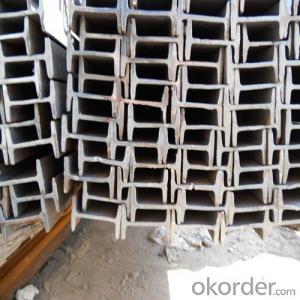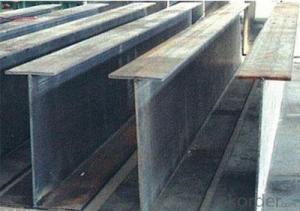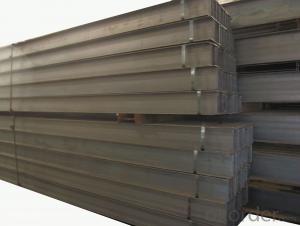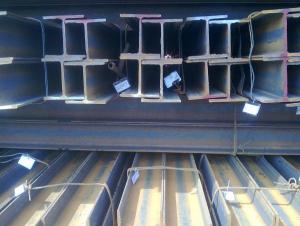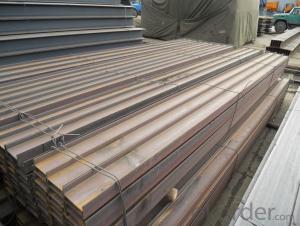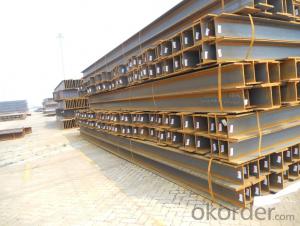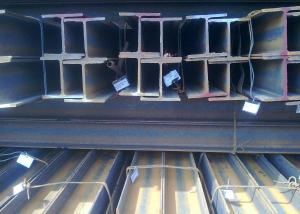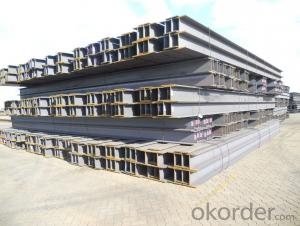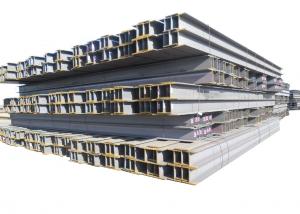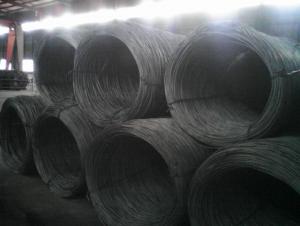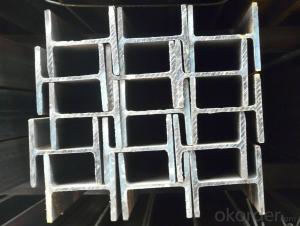Hot Rolled H Beam for Construction
- Loading Port:
- China Main Port
- Payment Terms:
- TT or LC
- Min Order Qty:
- 50MT m.t.
- Supply Capability:
- 10000MT m.t./month
OKorder Service Pledge
OKorder Financial Service
You Might Also Like
Specifications of Hot Rolled H Beam for Construction
1. Standard: JIS G 3192
2. Grade: SS400 or Equivalent
3. Length: 10m, 12m as following table
4. Invoicing on theoretical weight or actual weight as customer request
5. Payment: TT or L/C
6. Sizes:
H x B
(mm)
| T1 | T2 | JIS Weight
(kg/m)
|
100*100 | 6 | 8 | 16.9 |
125*125 | 6.5 | 9 | 23.6 |
150*75 | 5 | 7 | 14 |
148*100 | 6 | 9 | 20.7 |
150*150 | 7 | 10 | 31.1 |
175*90 | 5 | 8 | 18 |
175*175 | 7.5 | 11 | 40.4 |
198*99 | 4.5 | 7 | 17.8 |
200*100 | 5.5 | 8 | 20.9 |
194*150 | 6 | 9 | 29.9 |
200*200 | 8 | 12 | 49.9 |
248*124 | 5 | 8 | 25.1 |
250*125 | 6 | 9 | 29 |
244*175 | 7 | 11 | 43.6 |
250*250 | 9 | 14 | 71.8 |
298*149 | 5.5 | 8 | 32 |
298*201 | 9 | 14 | 65.4 |
300*150 | 6.5 | 9 | 36.7 |
294*200 | 8 | 12 | 55.8 |
300*300 | 10 | 15 | 93 |
346*174 | 6 | 9 | 41.2 |
350*175 | 7 | 11 | 49.4 |
340*250 | 9 | 14 | 78.1 |
350*350 | 12 | 19 | 135 |
400*200 | 8 | 13 | 65.4 |
390*300 | 10 | 16 | 105 |
400*400 | 13 | 21 | 172 |
446*199 | 8 | 12 | 65.1 |
450*200 | 9 | 14 | 77.9 |
440*300 | 11 | 18 | 121 |
496*199 | 9 | 14 | 77.9 |
500*200 | 10 | 16 | 88.2 |
488*300 | 11 | 18 | 125 |
596*199 | 10 | 15 | 92.5 |
600*200 | 11 | 17 | 103.4 |
588*300 | 12 | 20 | 147 |
700*300 | 13 | 24 | 182 |
800*300 | 14 | 26 | 207 |
900*300 | 16 | 28 | 240.1 |
Usage & Applications of Hot Rolled H Beam for Construction
Commercial building structure ;Pre-engineered buildings; Machinery support structure; Prefabricated structure; Medium scale bridges; Ship-building structure.etc.
Packaging & Delivery ofHot Rolled H Beam for Construction
1. Packing: it is nude packed in bundles by steel wire rod
2. Bundle weight: not more than 3.5MT for bulk vessel; less than 3 MT for container load
3. Marks:
Color marking: There will be color marking on both end of the bundle for the cargo delivered by bulk vessel. That makes it easily to distinguish at the destination port.
Tag mark: there will be tag mark tied up on the bundles. The information usually including supplier logo and name, product name, made in China, shipping marks and other information request by the customer.
If loading by container the marking is not needed, but we will prepare it as customer request.
4. Transportation: the goods are delivered by truck from mill to loading port, the maximum quantity can be loaded is around 40MTs by each truck. If the order quantity cannot reach the full truck loaded, the transportation cost per ton will be little higher than full load.
5. Delivered by container or bulk vessel
Production flow of Hot Rolled H Beam for Construction
Material prepare (billet) —heat up—rough rolling—precision rolling—cooling—packing—storage and transportation

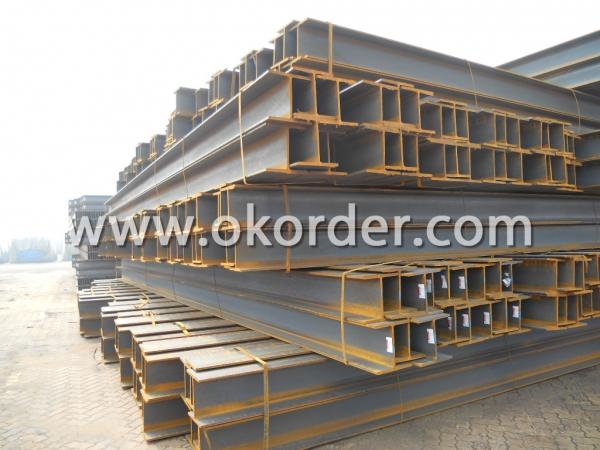
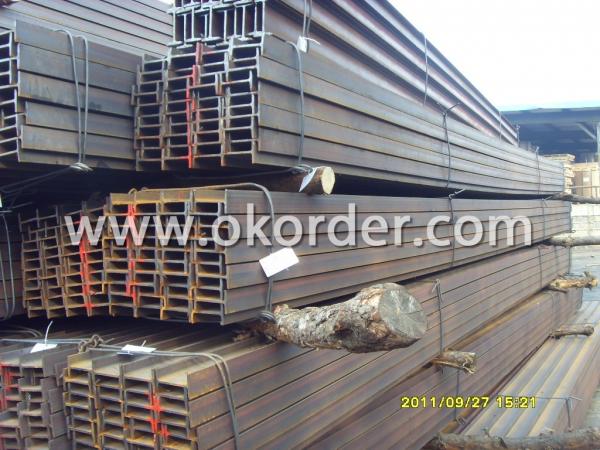
- Q: Can steel H-beams be used in the construction of religious buildings or churches?
- Religious buildings or churches can indeed utilize steel H-beams for their construction. The employment of steel H-beams in construction projects offers numerous benefits, such as their exceptional strength, durability, and versatility. These beams provide a robust framework capable of supporting the structure's weight and withstanding diverse weather conditions. Moreover, steel H-beams can be easily fabricated and tailored to suit different architectural designs, allowing for flexibility in the construction of religious buildings or churches. Consequently, their popularity in construction projects has grown due to their cost-effectiveness, sustainability, and ability to comply with building codes and safety requirements. Ultimately, the decision to incorporate steel H-beams in the construction of religious buildings or churches depends on various factors, including the project's architectural vision, structural demands, and budgetary considerations.
- Q: What is the purpose of using H-beams?
- H-beams, also known as I-beams or universal beams, have a crucial role in the construction industry. They serve to provide structural support and strength to different types of structures, including buildings, bridges, and other infrastructure projects. The distinctive shape of H-beams, resembling the letter "H" when viewed from the cross-section, is one of their key advantages. This design enables H-beams to distribute weight evenly and effectively, making them ideal for carrying heavy loads and resisting bending or deflection. The top and bottom flanges of the beam offer resistance against compressive and tensile forces, while the web in between ensures stability and prevents buckling. The purpose of using H-beams is to establish a stable and durable framework for various structures, ensuring their longevity and safety. They are frequently used in the construction of high-rise buildings, as they can support significant vertical loads, such as the weight of multiple floors, walls, and equipment. In bridge construction, H-beams are commonly utilized due to their strength and load-bearing capacity being crucial. Engineers can design bridges capable of withstanding heavy traffic loads and environmental forces by employing H-beams, thereby ensuring the safety and functionality of these critical transportation structures. Furthermore, H-beams find applications in industrial structures, such as warehouses and factories, where they provide necessary support for heavy machinery, cranes, and storage systems. The robustness and stability of H-beams make them an excellent choice for such applications, guaranteeing the integrity and functionality of the structures. In summary, the purpose behind using H-beams is to provide structural support and strength to various construction projects, including buildings, bridges, and industrial structures. Their unique shape and design allow for efficient weight distribution, resistance against bending, and overall stability. As a result, they have become an indispensable component in modern construction practices.
- Q: 300 * 150 * 6.5 * 9 H steel is used as steel beam, span 6 meters, spacing 2 meters, laying steel plate, 15 cm soil
- The concrete strength grade of the slab does not know, the reinforcement does not know, the bearing capacity of the board can afford, it can not be calculated.
- Q: Is the beam made of I-beam or H?
- The I-shaped and H type are actually the same shape, which refers to the appearance of the formed steel beam, usually called the H type steel beam.
- Q: What are the different fabrication methods for steel H-beams?
- The different fabrication methods for steel H-beams include hot rolling, welding, and cold forming. Hot rolling involves heating the steel to a high temperature and passing it through rollers to shape it into the desired H-beam profile. Welding involves joining individual steel plates or sections together to create the H-beam shape. Cold forming, on the other hand, uses hydraulic or mechanical presses to shape the steel into the H-beam profile without heating it. Each method has its own advantages and suitability for different applications.
- Q: Are there any design guidelines or codes for using steel H-beams?
- Yes, there are design guidelines and codes for using steel H-beams. These guidelines and codes are provided by various organizations such as the American Institute of Steel Construction (AISC) in the United States or the Eurocodes in Europe. These guidelines cover various aspects including the design, fabrication, and erection of steel H-beams to ensure their structural integrity and safety in different applications.
- Q: Can steel H-beams be used in industrial buildings?
- Yes, steel H-beams are commonly used in industrial buildings due to their strength, durability, and versatility. They provide excellent structural support and can withstand heavy loads, making them ideal for large-scale industrial construction projects.
- Q: How are steel H-beams protected against rust and corrosion?
- There are various methods available to protect steel H-beams from rust and corrosion. One commonly used technique involves applying a protective coating, such as paint or epoxy, to create a barrier between the steel and its surroundings. This coating prevents moisture and oxygen from reaching the metal surface and causing corrosion. To ensure maximum protection, multiple layers of the coating are typically applied. Another method is galvanization, which entails immersing the steel beams in molten zinc. This process creates a sacrificial barrier of zinc on the steel's surface. The zinc layer corrodes first, safeguarding the underlying steel from rusting. Galvanization is particularly effective in harsh environments and provides excellent corrosion protection. Corrosion inhibitors can also be used to treat steel H-beams. These chemicals can be applied as a coating or through a dipping process. They create a protective film on the metal surface, inhibiting the corrosion process. To maintain long-term protection against rust and corrosion, it is crucial to conduct regular maintenance and inspections. Any damages or breaches in the protective coating should be promptly addressed, and the beams should be regularly cleaned to remove accumulated dirt, debris, and corrosive substances. In conclusion, a combination of protective coatings, galvanization, and corrosion inhibitors, along with proper maintenance, can effectively safeguard steel H-beams from rust and corrosion. This approach extends their lifespan and ensures structural integrity.
- Q: Are there any limitations or restrictions on the use of steel H-beams?
- Yes, there are certain limitations and restrictions on the use of steel H-beams. Some of the key considerations include: 1. Load-bearing capacity: Steel H-beams have specific load-bearing capacities based on their size, shape, and material grade. It is crucial to ensure that the selected H-beam can withstand the anticipated loads and stresses in a given application. Exceeding the load-bearing capacity can lead to structural failure. 2. Span length: The span length, or the distance between supports, is an important factor to consider when using steel H-beams. Longer spans may require larger and stronger beams to ensure structural integrity. Consulting structural engineers or relevant building codes can help determine the appropriate span length for a given application. 3. Structural design: Steel H-beams should be used according to proper design guidelines and engineering principles. It is essential to follow structural design codes and regulations to ensure safety and compliance. 4. Environmental conditions: Steel H-beams can be susceptible to corrosion, especially in harsh environmental conditions. In such cases, additional protective measures like coatings or galvanization may be necessary to enhance their durability. 5. Welding and fabrication: Steel H-beams often require welding or fabrication during installation. It is crucial to follow proper welding procedures and techniques to maintain the structural integrity of the beams. Improper welding or fabrication can weaken the beams and compromise their load-bearing capacity. 6. Fire resistance: Steel H-beams are generally not fire-resistant. In fire-prone environments, additional fireproofing measures like fire-resistant coatings or insulation may be required to protect the beams and maintain their structural stability during a fire. 7. Code compliance: Local building codes and regulations may impose specific limitations or restrictions on the use of steel H-beams. It is important to be aware of and adhere to these codes to ensure compliance and safety. It is recommended to consult with a structural engineer or relevant professionals to assess the specific limitations and restrictions that may apply in a particular use case.
- Q: Can steel H-beams be used for supporting solar panels?
- Absolutely! Steel H-beams are an excellent choice for supporting solar panels. These beams are widely used in construction as they possess remarkable strength, durability, and load-bearing capabilities. When it comes to solar panel installations, H-beams provide a robust framework that securely holds and supports the panels. With the inherent strength of steel, the beams can effortlessly withstand the weight of the panels, even in challenging weather conditions. Additionally, steel's versatility allows for customization and adaptability to meet various installation requirements. Whether it's a rooftop or ground-mounted solar array, steel H-beams can effectively serve as the primary support structure for solar panels.
1. Manufacturer Overview
| Location | Tangshan, China |
| Year Established | 2007 |
| Annual Output Value | Above US$ 80 Million |
| Main Markets | Mid East; Southeast aisa; korea |
| Company Certifications |
2. Manufacturer Certificates
| a) Certification Name | |
| Range | |
| Reference | |
| Validity Period |
3. Manufacturer Capability
| a) Trade Capacity | |
| Nearest Port | Tianjin; |
| Export Percentage | 20% - 25% |
| No.of Employees in Trade Department | 11-15 People |
| Language Spoken: | English; Chinese |
| b) Factory Information | |
| Factory Size: | Above 75,000 square meters |
| No. of Production Lines | 1 |
| Contract Manufacturing | OEM Service Offered; |
| Product Price Range | Average |
Send your message to us
Hot Rolled H Beam for Construction
- Loading Port:
- China Main Port
- Payment Terms:
- TT or LC
- Min Order Qty:
- 50MT m.t.
- Supply Capability:
- 10000MT m.t./month
OKorder Service Pledge
OKorder Financial Service
Similar products
Hot products
Hot Searches
Related keywords



